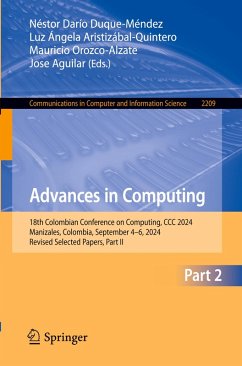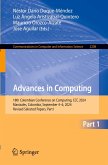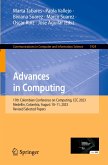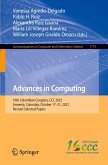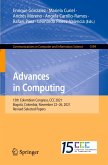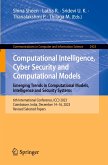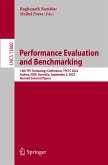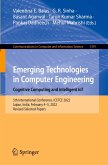Advances in Computing
18th Colombian Conference on Computing, CCC 2024, Manizales, Colombia, September 4-6, 2024, Revised Selected Papers, Part II
Herausgegeben:Duque-Méndez, Néstor Darío; Aristizábal-Quintero, Luz Ángela; Orozco-Alzate, Mauricio; Aguilar, Jose
Advances in Computing
18th Colombian Conference on Computing, CCC 2024, Manizales, Colombia, September 4-6, 2024, Revised Selected Papers, Part II
Herausgegeben:Duque-Méndez, Néstor Darío; Aristizábal-Quintero, Luz Ángela; Orozco-Alzate, Mauricio; Aguilar, Jose
- Broschiertes Buch
- Merkliste
- Auf die Merkliste
- Bewerten Bewerten
- Teilen
- Produkt teilen
- Produkterinnerung
- Produkterinnerung
This two-volume set CCIS 2208-2209 constitutes revised selected papers from the refereed proceedings of the 18th Colombian Congress on Computing, CCC 2024, held in Manizales, Colombia, during September 4-6, 2024.
The 50 full papers and 5 short papers included in this book were carefully reviewed and selected from 124 submissions. They were organized in topical sections as follows: Artificial Intelligence; Pattern recognition and computer vision; Computational statistics and formal methods; Cyber security and information security; Data, information and knowledge; ICT for education and…mehr
Andere Kunden interessierten sich auch für
![Advances in Computing Advances in Computing]() Advances in Computing57,99 €
Advances in Computing57,99 €![Advances in Computing Advances in Computing]() Advances in Computing68,99 €
Advances in Computing68,99 €![Advances in Computing Advances in Computing]() Advances in Computing49,99 €
Advances in Computing49,99 €![Advances in Computing Advances in Computing]() Advances in Computing49,99 €
Advances in Computing49,99 €![Computational Intelligence, Cyber Security and Computational Models. Emerging Trends in Computational Models, Intelligence and Security Systems Computational Intelligence, Cyber Security and Computational Models. Emerging Trends in Computational Models, Intelligence and Security Systems]() Computational Intelligence, Cyber Security and Computational Models. Emerging Trends in Computational Models, Intelligence and Security Systems46,99 €
Computational Intelligence, Cyber Security and Computational Models. Emerging Trends in Computational Models, Intelligence and Security Systems46,99 €![Performance Evaluation and Benchmarking Performance Evaluation and Benchmarking]() Performance Evaluation and Benchmarking42,99 €
Performance Evaluation and Benchmarking42,99 €![Emerging Technologies in Computer Engineering: Cognitive Computing and Intelligent IoT Emerging Technologies in Computer Engineering: Cognitive Computing and Intelligent IoT]() Emerging Technologies in Computer Engineering: Cognitive Computing and Intelligent IoT98,99 €
Emerging Technologies in Computer Engineering: Cognitive Computing and Intelligent IoT98,99 €-
-
-
This two-volume set CCIS 2208-2209 constitutes revised selected papers from the refereed proceedings of the 18th Colombian Congress on Computing, CCC 2024, held in Manizales, Colombia, during September 4-6, 2024.
The 50 full papers and 5 short papers included in this book were carefully reviewed and selected from 124 submissions. They were organized in topical sections as follows: Artificial Intelligence; Pattern recognition and computer vision; Computational statistics and formal methods; Cyber security and information security; Data, information and knowledge; ICT for education and e-Learning; Industry 4.0 and digital transformation; Software engineering and automation.
The 50 full papers and 5 short papers included in this book were carefully reviewed and selected from 124 submissions. They were organized in topical sections as follows: Artificial Intelligence; Pattern recognition and computer vision; Computational statistics and formal methods; Cyber security and information security; Data, information and knowledge; ICT for education and e-Learning; Industry 4.0 and digital transformation; Software engineering and automation.
Produktdetails
- Produktdetails
- Communications in Computer and Information Science 2209
- Verlag: Springer / Springer Nature Switzerland / Springer, Berlin
- Artikelnr. des Verlages: 978-3-031-75235-3
- Seitenzahl: 472
- Erscheinungstermin: 22. Dezember 2024
- Englisch
- Abmessung: 235mm x 155mm x 26mm
- Gewicht: 710g
- ISBN-13: 9783031752353
- ISBN-10: 303175235X
- Artikelnr.: 71524493
- Herstellerkennzeichnung
- Springer-Verlag KG
- Sachsenplatz 4-6
- 1201 Wien, AT
- ProductSafety@springernature.com
- Communications in Computer and Information Science 2209
- Verlag: Springer / Springer Nature Switzerland / Springer, Berlin
- Artikelnr. des Verlages: 978-3-031-75235-3
- Seitenzahl: 472
- Erscheinungstermin: 22. Dezember 2024
- Englisch
- Abmessung: 235mm x 155mm x 26mm
- Gewicht: 710g
- ISBN-13: 9783031752353
- ISBN-10: 303175235X
- Artikelnr.: 71524493
- Herstellerkennzeichnung
- Springer-Verlag KG
- Sachsenplatz 4-6
- 1201 Wien, AT
- ProductSafety@springernature.com
.- Data, information and knowledge.
.- Comparing Regression Models with enhanced Interpretability for Wind Speed Forecasting in La Guajira-Colombia.
.- Towards a closer patient-caregiver relationship by wearable and ambient assisted living design.
.- Influence of functional capacity in the living space (LS) in elders in small towns in the Colombian Andes: An analysis of the association between SPPB and LS.
.- Digital divide analysis in Colombia and Mexico using complex networks and open data platforms.
.- Evaluating pre-attentive perception of visibility graphs for representing ECG signals.
.- System for self-care support of inpatient and/or home care patients by monitoring vital signs with an IoT-self- adaptive prototype: a systematic study.
.- Parkinson Disease Rehabilitation Routines Described as Robot Instructions for PARKIBIP.
.- ICT for education and e-Learning.
.- Educational Strategies and Tools Based on AI: A Systematic Mapping for the Personalization of Learning.
.- Trends in Adaptive Graphical User Interfaces in Moodle LMS Systems through Artificial Intelligence techniques.
.- GAMITIC- ICT Literacy Tool for Teachers in Vulnerable Zones.
.- Computational Thinking (CT) Measurement Model based on Bloom's Taxonomy and the GQM model.
.- Enhancing Vocational Guidance with Machine Learning: Predicting STEM Career Viability for High School Students.
.- Student attrition in higher education: A systematic mapping of causes and retention strategies.
.- Case study: Design of a training strategy to improve learning outcomes through the development of integrative projects.
.- Data Generation Strategies for the Application of Adaptive Learning Analytics.
.- Reference Model of Appropriation of Digital Technologies for Learning in Higher Education Institutions.
.- Esmeralda: Support for Early Detection and Initial Attention to Dyslexia in First Grade Students through the Development of Digital Educational Resources.
.- Women in STEAM through the Lens of an Immersive-based Storytelling Design.
.- Industry 4.0 and digital transformation.
.- Evaluating Motivation for initiating a Digital Transformation Process in MSMEs.
.- Analysis of Ipv6 Adoption in The Last Seven Years: A Systematic Mapping.
.- Advanced Traffic Differentiation in LoRaWAN IIoT Networks through Contention Window Strategies.
.- Lightweight and Interpretable DL Model Using Convolutional RFF for AMC.
.- Model Driven Engineering tool for the generation of interoperable smart contracts.
.- Development of a Robotic UV-C Device as an Alternative to Chemical Disinfection.
.- An Analysis of Technological Applications in Community Policing and Their Performance Assessment Through A Systematic Review.
.- Software engineering and automation.
.- Implementation of a Process Optimization Methodology using Aspen Plus and Python.
.- Revisi´on Sistem´atica de Literatura sobre Automatizaci´on del Proceso Software.
.- Estudia: A Recommendation System for Higher Education Career Choice.
.- Mining of repositories to understand productivity in remote work environments.
.- A Cloud-Agnostic Infrastructure Provisioning Approach for Scalable Microservices Architectures.
.- MiMoQ: A System for Experimentation of Microservice-Based Applications.
.- Comparing Regression Models with enhanced Interpretability for Wind Speed Forecasting in La Guajira-Colombia.
.- Towards a closer patient-caregiver relationship by wearable and ambient assisted living design.
.- Influence of functional capacity in the living space (LS) in elders in small towns in the Colombian Andes: An analysis of the association between SPPB and LS.
.- Digital divide analysis in Colombia and Mexico using complex networks and open data platforms.
.- Evaluating pre-attentive perception of visibility graphs for representing ECG signals.
.- System for self-care support of inpatient and/or home care patients by monitoring vital signs with an IoT-self- adaptive prototype: a systematic study.
.- Parkinson Disease Rehabilitation Routines Described as Robot Instructions for PARKIBIP.
.- ICT for education and e-Learning.
.- Educational Strategies and Tools Based on AI: A Systematic Mapping for the Personalization of Learning.
.- Trends in Adaptive Graphical User Interfaces in Moodle LMS Systems through Artificial Intelligence techniques.
.- GAMITIC- ICT Literacy Tool for Teachers in Vulnerable Zones.
.- Computational Thinking (CT) Measurement Model based on Bloom's Taxonomy and the GQM model.
.- Enhancing Vocational Guidance with Machine Learning: Predicting STEM Career Viability for High School Students.
.- Student attrition in higher education: A systematic mapping of causes and retention strategies.
.- Case study: Design of a training strategy to improve learning outcomes through the development of integrative projects.
.- Data Generation Strategies for the Application of Adaptive Learning Analytics.
.- Reference Model of Appropriation of Digital Technologies for Learning in Higher Education Institutions.
.- Esmeralda: Support for Early Detection and Initial Attention to Dyslexia in First Grade Students through the Development of Digital Educational Resources.
.- Women in STEAM through the Lens of an Immersive-based Storytelling Design.
.- Industry 4.0 and digital transformation.
.- Evaluating Motivation for initiating a Digital Transformation Process in MSMEs.
.- Analysis of Ipv6 Adoption in The Last Seven Years: A Systematic Mapping.
.- Advanced Traffic Differentiation in LoRaWAN IIoT Networks through Contention Window Strategies.
.- Lightweight and Interpretable DL Model Using Convolutional RFF for AMC.
.- Model Driven Engineering tool for the generation of interoperable smart contracts.
.- Development of a Robotic UV-C Device as an Alternative to Chemical Disinfection.
.- An Analysis of Technological Applications in Community Policing and Their Performance Assessment Through A Systematic Review.
.- Software engineering and automation.
.- Implementation of a Process Optimization Methodology using Aspen Plus and Python.
.- Revisi´on Sistem´atica de Literatura sobre Automatizaci´on del Proceso Software.
.- Estudia: A Recommendation System for Higher Education Career Choice.
.- Mining of repositories to understand productivity in remote work environments.
.- A Cloud-Agnostic Infrastructure Provisioning Approach for Scalable Microservices Architectures.
.- MiMoQ: A System for Experimentation of Microservice-Based Applications.
.- Data, information and knowledge.
.- Comparing Regression Models with enhanced Interpretability for Wind Speed Forecasting in La Guajira-Colombia.
.- Towards a closer patient-caregiver relationship by wearable and ambient assisted living design.
.- Influence of functional capacity in the living space (LS) in elders in small towns in the Colombian Andes: An analysis of the association between SPPB and LS.
.- Digital divide analysis in Colombia and Mexico using complex networks and open data platforms.
.- Evaluating pre-attentive perception of visibility graphs for representing ECG signals.
.- System for self-care support of inpatient and/or home care patients by monitoring vital signs with an IoT-self- adaptive prototype: a systematic study.
.- Parkinson Disease Rehabilitation Routines Described as Robot Instructions for PARKIBIP.
.- ICT for education and e-Learning.
.- Educational Strategies and Tools Based on AI: A Systematic Mapping for the Personalization of Learning.
.- Trends in Adaptive Graphical User Interfaces in Moodle LMS Systems through Artificial Intelligence techniques.
.- GAMITIC- ICT Literacy Tool for Teachers in Vulnerable Zones.
.- Computational Thinking (CT) Measurement Model based on Bloom's Taxonomy and the GQM model.
.- Enhancing Vocational Guidance with Machine Learning: Predicting STEM Career Viability for High School Students.
.- Student attrition in higher education: A systematic mapping of causes and retention strategies.
.- Case study: Design of a training strategy to improve learning outcomes through the development of integrative projects.
.- Data Generation Strategies for the Application of Adaptive Learning Analytics.
.- Reference Model of Appropriation of Digital Technologies for Learning in Higher Education Institutions.
.- Esmeralda: Support for Early Detection and Initial Attention to Dyslexia in First Grade Students through the Development of Digital Educational Resources.
.- Women in STEAM through the Lens of an Immersive-based Storytelling Design.
.- Industry 4.0 and digital transformation.
.- Evaluating Motivation for initiating a Digital Transformation Process in MSMEs.
.- Analysis of Ipv6 Adoption in The Last Seven Years: A Systematic Mapping.
.- Advanced Traffic Differentiation in LoRaWAN IIoT Networks through Contention Window Strategies.
.- Lightweight and Interpretable DL Model Using Convolutional RFF for AMC.
.- Model Driven Engineering tool for the generation of interoperable smart contracts.
.- Development of a Robotic UV-C Device as an Alternative to Chemical Disinfection.
.- An Analysis of Technological Applications in Community Policing and Their Performance Assessment Through A Systematic Review.
.- Software engineering and automation.
.- Implementation of a Process Optimization Methodology using Aspen Plus and Python.
.- Revisi´on Sistem´atica de Literatura sobre Automatizaci´on del Proceso Software.
.- Estudia: A Recommendation System for Higher Education Career Choice.
.- Mining of repositories to understand productivity in remote work environments.
.- A Cloud-Agnostic Infrastructure Provisioning Approach for Scalable Microservices Architectures.
.- MiMoQ: A System for Experimentation of Microservice-Based Applications.
.- Comparing Regression Models with enhanced Interpretability for Wind Speed Forecasting in La Guajira-Colombia.
.- Towards a closer patient-caregiver relationship by wearable and ambient assisted living design.
.- Influence of functional capacity in the living space (LS) in elders in small towns in the Colombian Andes: An analysis of the association between SPPB and LS.
.- Digital divide analysis in Colombia and Mexico using complex networks and open data platforms.
.- Evaluating pre-attentive perception of visibility graphs for representing ECG signals.
.- System for self-care support of inpatient and/or home care patients by monitoring vital signs with an IoT-self- adaptive prototype: a systematic study.
.- Parkinson Disease Rehabilitation Routines Described as Robot Instructions for PARKIBIP.
.- ICT for education and e-Learning.
.- Educational Strategies and Tools Based on AI: A Systematic Mapping for the Personalization of Learning.
.- Trends in Adaptive Graphical User Interfaces in Moodle LMS Systems through Artificial Intelligence techniques.
.- GAMITIC- ICT Literacy Tool for Teachers in Vulnerable Zones.
.- Computational Thinking (CT) Measurement Model based on Bloom's Taxonomy and the GQM model.
.- Enhancing Vocational Guidance with Machine Learning: Predicting STEM Career Viability for High School Students.
.- Student attrition in higher education: A systematic mapping of causes and retention strategies.
.- Case study: Design of a training strategy to improve learning outcomes through the development of integrative projects.
.- Data Generation Strategies for the Application of Adaptive Learning Analytics.
.- Reference Model of Appropriation of Digital Technologies for Learning in Higher Education Institutions.
.- Esmeralda: Support for Early Detection and Initial Attention to Dyslexia in First Grade Students through the Development of Digital Educational Resources.
.- Women in STEAM through the Lens of an Immersive-based Storytelling Design.
.- Industry 4.0 and digital transformation.
.- Evaluating Motivation for initiating a Digital Transformation Process in MSMEs.
.- Analysis of Ipv6 Adoption in The Last Seven Years: A Systematic Mapping.
.- Advanced Traffic Differentiation in LoRaWAN IIoT Networks through Contention Window Strategies.
.- Lightweight and Interpretable DL Model Using Convolutional RFF for AMC.
.- Model Driven Engineering tool for the generation of interoperable smart contracts.
.- Development of a Robotic UV-C Device as an Alternative to Chemical Disinfection.
.- An Analysis of Technological Applications in Community Policing and Their Performance Assessment Through A Systematic Review.
.- Software engineering and automation.
.- Implementation of a Process Optimization Methodology using Aspen Plus and Python.
.- Revisi´on Sistem´atica de Literatura sobre Automatizaci´on del Proceso Software.
.- Estudia: A Recommendation System for Higher Education Career Choice.
.- Mining of repositories to understand productivity in remote work environments.
.- A Cloud-Agnostic Infrastructure Provisioning Approach for Scalable Microservices Architectures.
.- MiMoQ: A System for Experimentation of Microservice-Based Applications.

